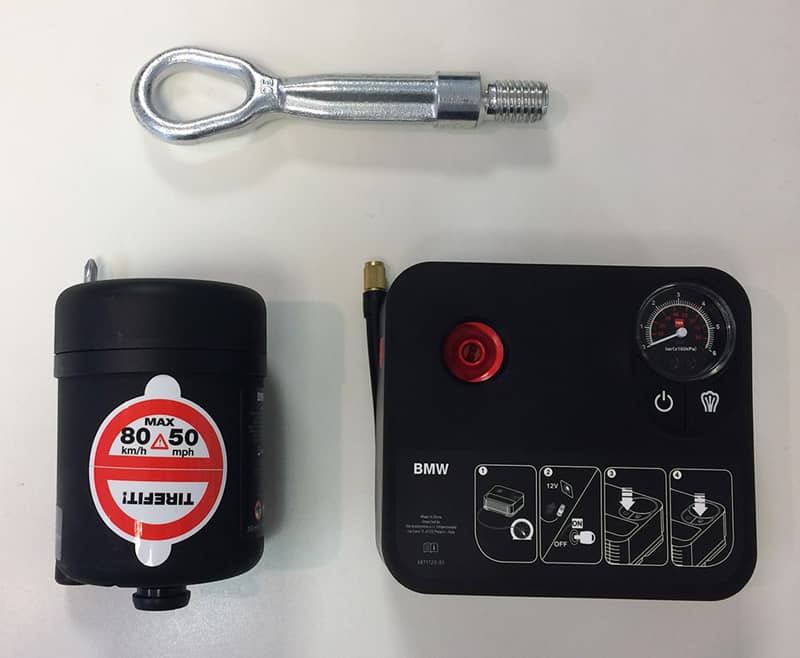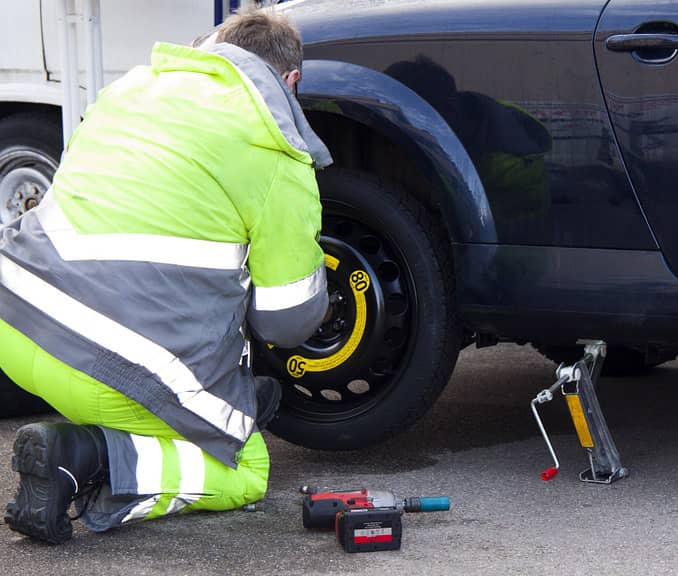Spare Tyres
The purpose of a spare tyre is to provide you with a mode of transport should one of your tyres be punctured or otherwise damaged whilst driving. To save space and weight, some car tyre manufacturers may provide tyre repair kits instead of spare tyres and many vehicles are being fitted with run flat tyres to make the spare tyre less essential.
Tyre Repair Kits

Many vehicle manufacturers choose to supply cars with a tyre repair kit rather than a spare tyre due to the fact that they save space, allowing more room in the boot, and save weight, improving fuel consumption. These kits can vary, however, they will usually contain a sealant and a tyre inflator pack.
When using a tyre repair kit you must follow the instructions on the pack. Typically, the sealant solution will need to be injected through the tyre valve and the tyre will then need to be inflated but you must follow the guide provided with the kit.
Tyre repair kits are intended as a temporary measure and while they will enable you to drive home or to a tyre specialist, you must maintain a slow speed, as specified by the instructions on the kit, and have your tyre replaced as soon as possible.
Advantages:
- A tyre repair kit provides more space and less weight in comparison to carrying a spare tyre.
- Using a tyre repair kit is easier and less strenuous than changing a tyre.
Disadvantages:
- Sealants cannot be considered as permanent repairs and you must replace your tyre as soon as possible.
- Tyres which have been repaired using one of these kits cannot be repaired by a tyre specialist.
- If the tyre damage sustained is too large, it is unlikely that the tyre repair kit will work.
Run-Flat Tyres
Run-flat tyres are tyres that have been built with reinforced sidewalls to enable you to drive on for a short period at a reduced speed after suffering a puncture. This should allow you enough time to make it home or to a tyre specialist.
Vehicles that are fitted with four run-flat tyres as original equipment, will usually not be supplied with either a spare tyre or a tyre repair kit.
Advantages:
- Run-flat tyres eliminate the need to carry a spare tyre so there will be more room and less weight in your vehicle.
- No need to make any repairs yourself as you can drive safely to your local tyre specialist.
- Run-flat tyres provide enhanced levels of safety as after suffering a puncture or loss of tyre pressure, run-flat tyres enable the vehicle to be driven and handled as usual, although you will need to drive at a reduced speed.
Disadvantages:
- Run-flat tyres cannot be repaired once they have been damaged as any repairs could jeopardise the structural integrity of the tyre.
- Run-flat tyres wear more rapidly than standard tyres, so they may need to be replaced more frequently.
Note – if you wish to switch from conventional tyres to run-flat tyres or vice versa, you must first seek advice from a tyre specialist.
Spare Tyres
The fifth tyre that many motorists choose to carry in their boot when driving is referred to as the spare tyre. Usually stored underneath the floor panel in the boot of your vehicle, the spare tyre can be used to replace a damaged or punctured tyre.

As well as the tyre, you must also carry the equipment required to change it, including a tyre jack, a locking wheel nut, wheel wedges and gloves. It is important that your spare tyre is in good condition when you come to use it, so you must use a tyre with adequate levels of tyre tread and one that is in good condition. You should also regularly check the tyre pressure of your spare.
Advantages:
- After changing your tyre, you will be able to continue driving as usual – unless your spare tyre is a space saver tyre.
- Depending on the damage your tyre sustained, your tyre may be able to be repaired by a tyre specialist.
Disadvantages:
- Changing a tyre can be hard work – it is important that you know exactly what you are doing before attempting this task.
- Carrying a spare tyre takes up room and weight in your vehicle.
For more information on tyre safety or for guidance on spare tyres, tyre repair kits or run flat tyres, contact your your local Setyres branch.